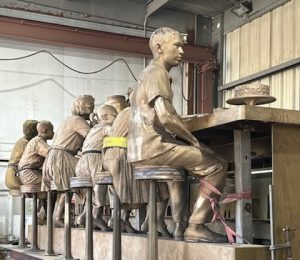
A seven-year effort to create a permanent monument to first successful sit-in to end whites-only accommodations in multiple states will be realized at 11 a.m. on Saturday, November 1 at the Clara Luper National Sit-In Plaza. The monument, representing Oklahoma City civil rights pioneer Clara Luper, the 13 students who staged the sit-in, along with a server who denied them service, is placed at Main Street and Robinson Avenue where the Katz Drug Store once stood.
The dedication ceremony will be led by Mayor David Holt with dozens of the original sit-in students in attendance.
The monument is in remembrance of the sit-in that started on August 19, 1958. teacher Clara Luper led 13 students, ages six to 17, into Katz Drug Store at the southwest corner of Main Street and Robinson Avenue and took their seats at the lunch counter where they asked to be served hamburgers and Coca-Cola. They knew their presence was not welcomed; the entire state was subject to Jim Crow laws since it was admitted to the union in 1907.
Luper’s daughter, Marilyn, age 10, suggested they stage a sit-in at Katz Drug Store. The store was a hub for the Black community, standing where Black bus passengers were dropped off. They were allowed to purchase goods and food at Katz Drug Store, but not allowed to eat at the lunch counter.
The children arrived on Tuesday night and they were asked to leave and not sit at the counter. A manager cursed at the group and demanded they leave. The police were called, but the children were committing no crime. When the store closed, the children returned the next morning. The abuse continued. The children arrived on a third day at which time Katz opened all of their 38 stores in four states to Black customers.
The sit-ins gained momentum across the country and Luper’s children were credited with inspiring the longest, non-violent sit-in movement in the country. The children expanded their sit-ins throughout Oklahoma City while others, including the better-known Greensboro sit-in 1960, was inspired by a report on the Oklahoma City movement at the 1959 NAACP national convention.
